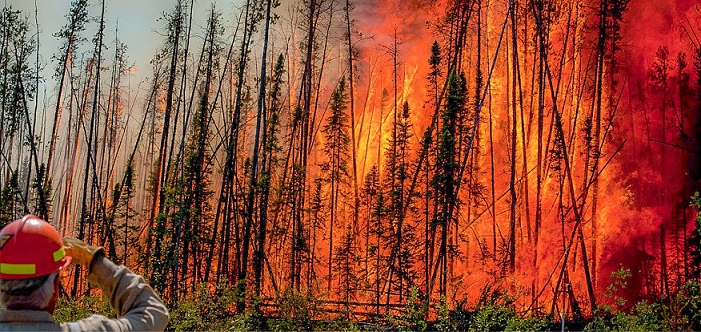
New research published today highlights how the risk of wildfire is not only rising globally due to climate change, but already at a pace faster than climate models have predicted.
The study, led by the University of East Anglia and co-authored by researchers at the Centre for Wildfire Research at Swansea University, the University of Exeter, the UK Met Office and international co-authors assessed 500 previous research papers and includes a re-analysis of state-of-the-art datasets from satellite observations and models.
It shows that anthropogenic climate change is an accelerating ‘push’ factor that enhances the risk of wildfires globally, but also that human actions at regional scales can act as ‘push’ or ‘pull’ factors.
Fire weather – the hot dry conditions conducive to wildfires - is increasing under climate change, raising the risk of large wildfires by making landscapes more susceptible to burn more often and more severely. Each added decimal degree of global warming further escalates wildfire risk.
Climate models suggest that, in some world regions, for example the Mediterranean and Amazonia, the frequency of fire weather conditions in the modern period is unprecedented compared with the recent historic climate, due to human induced global warming of around 1.1°C. If global temperatures reach 2-3°C of warming as per the current trajectory, this will be the case in virtually all world regions.
Climate models also show that the likelihood of some of the most recent and catastrophic wildfires in the western US, Australia and Canada has been significantly greater due to historical climate change.
Human actions have additional regional effects on wildfire a warming world. For example, we have increased fire ignitions and reduced the natural resilience of some ecosystems to fire, most notably in major tropical deforestation zones of Amazonia and Indonesia.
In contrast, we reduced the spread of wildfire through naturally fire-prone landscapes by converting land to agriculture and fragmenting the natural vegetation, as seen in savannah grasslands during recent decades.
We also reduce unwanted ignitions or use firefighting to suppress wildfires, as historically done in forests of the US, Australia and Mediterranean Europe. However, where fire is a natural component of the functioning of ecosystems, its exclusion has had unintended consequences.
For example, policies that aggressively excluded fire from the western US landscape during the 20th century resulted in excessive accumulation of vegetation fuels, contributing to more severe wildfires during recent droughts. The managed use of low-intensity fires at times with safe weather conditions is an important tool here for keeping fuels in check while also facilitating natural ecosystem functions.
Lead author Dr Matthew M Jones said: “Wildfires can have massive detrimental impacts on society, the economy, human health and livelihoods, biodiversity and carbon storage. These impacts are generally magnified in the case of forest wildfires.
“Clarifying the link between forest wildfire trends and climate change is critical to understanding wildfire threats in future climates. Societies can either push with or pull against the rising risks of fire under of climate change, and regional actions and policies will be important for reducing the threat from wildfire.
“Ultimately, though, cutting greenhouse gas emissions and limiting warming to below 2°C is the most effective thing we can do to avoid the worst risks of wildfire on the global scale.”
Co-author Dr Cristina Santín added: “Despite the fact that weather conditions promoting wildfire have already increased in nearly in every region the globe and will continue to do so, human factors still mediate or override the climatic ones in many regions."
Co-author Professor Stefan Doerr concluded: "We hope this research helps to resolve the entrenched and conflicting views on climate change versus land management being the root cause of catastrophic wildfires.”
Key findings include:
- The length of the annual fire weather season has increased by 14 days per year (27%) during 1979-2019 on average globally and the frequency of days with extreme fire weather has increased by 10 days per year (54%) during 1979-2019;
- Fire weather has risen significantly in most world regions since the 1980s. At 3°C, of warming, virtually all world regions will experience unprecedented fire weather;
- Regional human impacts in combination with reduced grassland productivity have reduced the area burned by fire in the vast tropical savannahs, but large increases have been observed elsewhere, especially in temperate and boreal forests. E.g. the area burned has increased by 21,400 km2 (93%) in east Siberian forests and by 3,400 km2 (54%) in the forests of western North America.
